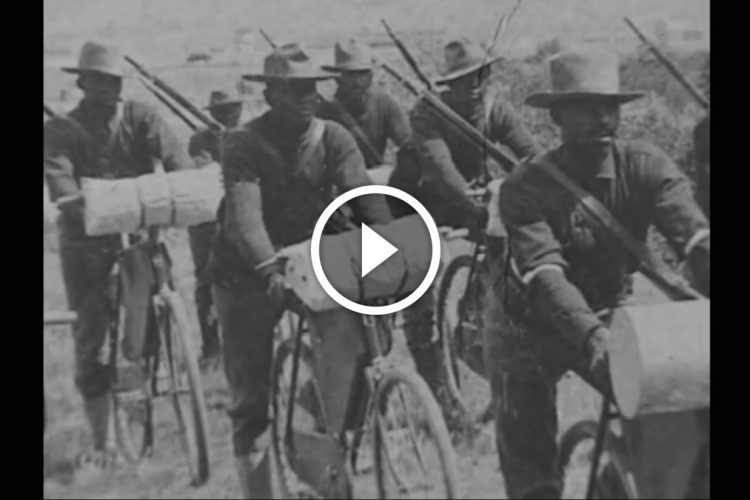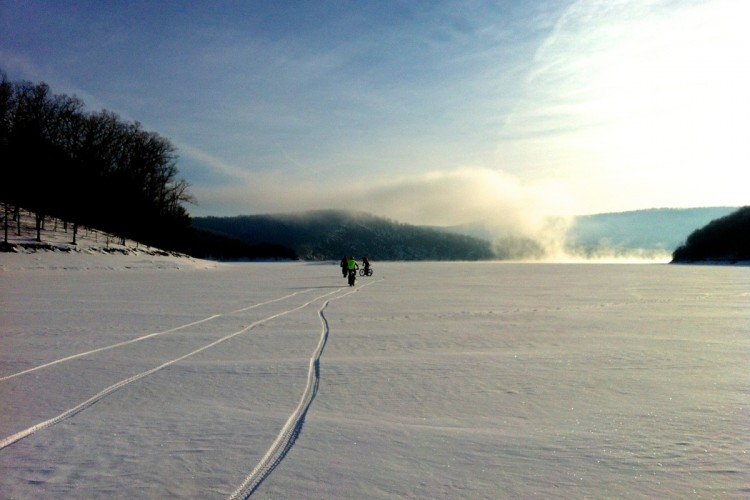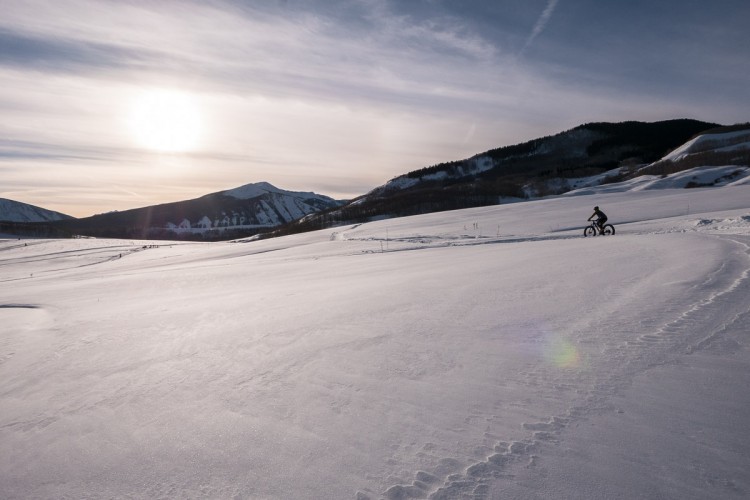Editor’s Note: When looking to get more serious about mountain biking, Aaron chose to buy a fat bike as his one-quiver bike–and the decision has been working out great for him! While Aaron Couch is a regular contributor to Singletracks.com, any opinions expressed in this article are his alone and do not necessarily represent the opinions of Singletracks.com.
You’re looking to upgrade your mountain bike, but you’re on a tight budget. That’s no surprise, as most of us are. Being on a tight budget, you want your money to go far. You need one bike with high-quality components, capable of handling a variety of terrain: dirt, rocks, sand, snow. Being on a budget means you can’t afford a new bike, or don’t want to. Buying a used suspension bike creates another issue: repairs and increased maintenance, meaning more time in the shop and less time on the trails.

These were the issues I faced when upgrading from my rigid Trek 820 Mountain Track. I needed suspension, better brakes, a larger frame for a better fit, access to better components, wider handlebars… need I go on? My Trek got me into mountain biking and had been all over from Kentucky to Kansas to Utah to Idaho and beyond.

Omniterra: The word means “all earth.” That’s what a fat bike is truly capable of. Fat tires, though not a replacement for suspension, still offer more grip and damping than a rigid 29” or 27.5” wheelset. Fat tires also enable year-round riding without limitations.

What about a plus tire bike?
I seriously considered this. I could ride most snow, right? It would have less rolling resistance than a fat tire and still be an upgrade. I had my eye on the Surly Krampus and Salsa Deadwood. But then the local bike shop pointed something out to me: You can install plus-size wheels on a fat bike frame, but you can’t put fat tires on a plus-sized frame. Simple as that, and this is what sold me.
There isn’t much difference between a plus tire bike and a fat bike, other than the size of the front fork and rear stays. Fat bikes offer the most versatility and best bang for the buck. Additionally, a plus-tire is not legal and doesn’t comply with the etiquette on groomed snow singletrack, where a tire width of 3.8” or wider is required.
[see_also id=”198077″][/see_also]
The Bike of Choice

I found a used, steel-frame Surly Pugsley Ops that included aftermarket carbon fiber handlebars and fork, and hydraulic brakes. The bike was set up tubeless with Rolling Darryl rims and 45nrth Husker Du tires. There were a bunch of other accessories included as well. I scored this for $700 – an awesome price! Knowing the seller helped, but even at $1000 this would have been a great deal.
As a Trail Bike: Dirt, Rocks, Sand


Dropping down steep slickrock, there are often large sandy patches. Any traditional tire width would make the landing pretty squirrelly. With a fat tire, you get the grip you need on the slickrock and control you need in the sand. Taking wide corners on loose soil is no problem. When descending down rocky, rooty, and rutted out trails, the 3.8 Surly Nate tires handle it all.

On Downhill, Drops and Jumps
“I’ve never thought of jumping a fat bike before,” was one of the reactions I got this fall when playing around at the local pump track and bike park. I’m not a “downhiller,” but can a rigid fat bike can handle 3-foot drops, gap jumps, and rock gardens? Absolutely. Go to YouTube and check out what athletes are doing on rigid fat bikes – it’s impressive.
[see_also id=”182136″][/see_also]


While Bikepacking and Cycling Long Distances
Riding a fat bike long distances certainly is more difficult than a cyclocross bike, but very possible. This past September (2016), I finished JayP’s 120-mile Gravel Pursuit on my fat bike.
[see_also id=”204282″][/see_also]
I recently bikepacked the full 155-mile Maah Daah Hey trail, which is 95% singletrack, in 4 days. I’ve gone on several 50 to 60-mile day rides, as well as bikepacking trips with 70+ mile back-to-back days.
[see_also id=”197940″][/see_also]


You could say the fat bike is the perfect bikepacking rig. Regardless of the conditions, you don’t have to carry your bike through roads and trails that might be impassable for most bikes.

During Questionable Trail Conditions
In my experience, fat tires are capable of passing through more variable conditions without damaging the trail. I’ve witnessed mountain bikers on 2.25 to 2.75-inch tires making ruts, while I roll right through the greasy spots, only leaving dimples from the tread. The fat bike is the perfect shoulder season companion.


Of course, fat tires don’t give you a free pass – you still have to use common sense. However, when going over soft sections of trail, it’s unlikely you’ll do damage. Without a doubt, fat tires have much less impact than traditional mountain bike tires.
Snow Riding

Obviously, this goes without saying that a fat bike is capable of such. When considering purchasing a fat bike, keep in mind what and where you will be riding. I would recommend you look at frames that support up to 5”-wide tires. You won’t use them in summer, but you’ll be glad you have the option when winter comes. That said, 3.8” tires will get you through most snow conditions. Check out our comprehensive guide to fat bike tires.
[see_also id=”204196″][/see_also]

Conclusion
Having a bike you can take anywhere and ask questions later is one less burden off your shoulders. Many of my trips lead to a a variety of locations and weather. Sometimes it rains or snows. Having a fat bike allows me to leave the uncertainty at the trailhead and go ride whatever my heart desires.

For the money, high-quality components and the option to ride year-round on all terrain, a fat bike is the true one-size-fits-all. It turns out you can have a high quality, inexpensive bike to tackle everything.






















12 Comments
Oct 31, 2017
Purchased a Mukluk carbon frame (w/ essential mounts) 1 wk ago to build my 3rd fatbike for snow, summer and solo tours.
Previously owned a 1st gen Mukluk and then (now) a carbon fiber beargrease 1X11 that I just rode the length of the GDMBR (26X3.0" tubeless). Shortly after acquiring the BG, I ended up selling my "seldom if ever used" and previously coveted Moots YBB.
Like "Thub", going to run a 27.5"X2.8" set up for non-winter, CO-UT XC riding (and summer bikepacking) and keep the 26"X70mm Whisky rim wheelset (XT brakes, Jones bars) from the BG for winter riding on beists....unsure if the drivetrain will be 1X11 vs. 12 tho the setup will remain, rigid.
Jan 31, 2017
Only other comment would be don't buy a straight steerer tube bike in 2017. Far less options, and less each day.
The ideal is 1 Fat Bike with ~120mm fork, 1 set of summer 27.5x 55-65mm rims on a 3.8's, and a set of 26x 80-100mm rims on 4.8+ for winter with studs.
At that point you just swap wheels for the appropriate conditions and you're off, anywhere you want to go. Even in a place with wildly changing winter conditions, you can swap between summer and winter tires in 5 minutes.
Feb 1, 2017
Feb 1, 2017
Feb 1, 2017
Feb 1, 2017
Additionally, you can put studs in fat bike tires.
Jan 31, 2017
Now if you live in Georgia, Arizona, etc.? I'd still probably go with a hardtail 29er. But like you said, you can always put 29+ hoops and tires on a fat bike, but you can't go the other way around!
Feb 1, 2017
Feb 1, 2017
Jan 31, 2017
Feb 1, 2017
Feb 1, 2017